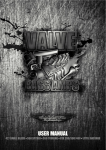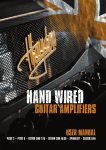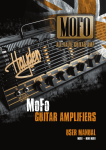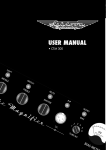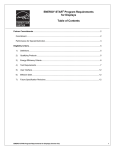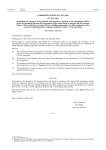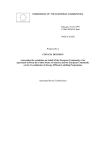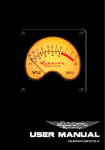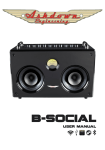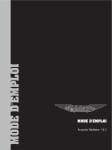Download USER MANUAL - Ashdown Amplification
Transcript
USER MANUAL 427 SMALL BLOCK • 550 SPYDER • 550 TOURING • BTA 200/300/400 • LITTLE BASTARD VALVE BASS AMPS USER MANUAL 427 SMALL BLOCK • 550 SPYDER • 550 TOURING • BTA 200/300/400 • LITTLE BASTARD WELCOME TO ASHDOWN VALVE BASS AMPS Thank you for choosing an Ashdown Valve Series amplifier. To ensure that you receive the full benefits of the Ashdown warranty, please register your amplifier at www.ashdownmusic.com protect the finish and, if you are transporting it with other equipment, make sure that the amplifier is on a solid floor at the bottom of the pile. WARRANTY Amplifiers are heavy. Take care when lifting, always use the handles fitted to the amplifier to move it, and get help if you have to lift the amplifier to a greater height than you feel comfortable with. Your amplifier is covered by a one year warranty, against defects in materials and workmanship, for the original purchaser. Ashdown will, at their discretion, replace or repair any product or part thereof, which is found by Ashdown to be defective. This warranty shall not apply to the damage of covering, fittings or finishes when affected by carelessness, accident or extreme climate changes. Nor does it apply to normal wear and tear of parts such as valves, fuses, light bulbs, speakers, controls etc. In the unlikely event of any defect, please contact an authorised Ashdown dealer. All transport charges are to be pre-paid by the Owner. Unless your purchase is registered on-line, normal country warranty laws apply. IMPORTANT SAFETY INSTRUCTIONS This Ashdown amplifier has been designed to provide you with many years of faithful service – on the road, in a studio or in a domestic environment. By following the rules set out below, you will ensure that the unit functions safely. Valve (tube) instrument amplifiers contain very high voltages and fragile glass tubes and should therefore be handled with care. A number of important precautions which must be observed are set out below. Before using the amplifier, run through the check list below. If you are in any doubt about any aspect of the amplifier’s operation, stop using it immediately and do not resume operation until the amplifier has been thoroughly inspected by a qualified technician. 1) Storage and moving When your amplifier is not in use make sure that the power cord is unplugged from the mains outlet, and that all leads are removed from the amplifier, including jack leads and footswitch leads. Jack socket connectors are self-cleaning, so the process of plugging in and unplugging the leads when not in use will ensure that the internal contacts will be cleaned when you plug in again. Store your amplifier in a warm, dry place away from moisture and condensation. A motor vehicle or cellar may look dry but condensation can form inside the unit causing short circuits and possible electric shock. If you suspect the amplifier may have become exposed to moisture, move it to a warm dry place and leave it to dry out for at least 48 hours before attempting to use it. Condensation can also occur when you move the amplifier from a hot humid place (such as a nightclub) to a cold place (like a motor vehicle). In such instances, always move the amplifier into a warm dry room to prevent damage. When moving the amplifier, handle it as carefully as you would your instruments. Although solidly built, an amplifier is easily damaged by shock, so be careful not to drop it or allow it to fall over. Use a protective cover to Never attempt to operate the amplifier after it has been dropped. Take it to a qualified technician and have it checked before using it again. 2) Leads and plugs Your amplifier contains possibly lethal voltages and must therefore be connected to the mains using the correct power cord, which is a three terminal type with a ground connection. The power cord supplied with the unit should be of the correct type. If it does not fit your mains outlet consult your dealer or a qualified electrician for advice before attempting to use the amplifier. Never modify the power cord or attempt to use it with a two pin outlet. Store all your leads in a dry case and take care when packing them away. All leads, including guitar leads, are easily damaged with careless handling, so it is a good idea to carry a spare lead of every type you use. Flexible power cords get damaged very easily. At the first sign of damage, discard it and purchase a new one. Always replace the power cord with one of the same type. Moulded cords are the best choice with both plugs permanently fitted to the cord. When using your amplifier and other equipment it is a good idea to connect to the supply using a unit known as an R.C.D. These units are not expensive and offer the user additional protection against electric shock. An electrical shop should be able to supply you with a suitable unit. 3) Before Use Inspect your amplifier for damage before use. Check each lead for damage before you plug them in to the amplifier, and ensure that the loudspeaker is connected before you switch the amplifier on. Never try to operate the amplifier without the speaker connected. If you do, serious damage to the amplifier will result which will be very expensive to repair. Double check the connections you have made to your amplifier and make sure you have connected the speaker to the correct outlet socket that matches the cabinet you are using. The impedance of the speaker is important and is usually shown on a plate affixed to the back of the cabinet, so if the cabinet is 16R (Ohms) then you plug into the 16R outlet on the amplifier. 4) Using the amplifier When you set the amplifier up for use, it is important that you adhere to the following rules: Place the amplifier away from sources of heat, including radiators, etc. The amplifier itself will get hot in normal use. Make sure that all the grilles on the amplifier are not obstructed in any way so that cooling air can circulate through the amplifier. Do not place anything on or behind the amplifier that might restrict the flow of air. This includes items of clothing, or other equipment. Do not place the amplifier in such a position where it may get splashed with liquid or water, e.g. near tables of drinks or near equipment that contains water, e.g. smoke and bubble machines The lightning flash within a triangle is intended to alert the user to the presence of un-insulated dangerous voltage within the product enclosure that may be of sufficient magnitude to constitute a risk of electric shock. Never stand bottles or containers of liquid on the amplifier. If any liquid is accidentally spilled into the amplifier, unplug it from the mains supply immediately and take the amplifier to a qualified technician for inspection. This highlights the presence of dangerous voltages within the equipment enclosure. Never try to operate the unit out of the enclosure. Do not place objects on the amplifier that could fall inside and cause a malfunction, e.g. coins, tools, etc. 5) Sound level The level of sound or ‘volume’ you choose to use will mainly be dependant on the size of the room you are playing in and you should use the volume level that gives you the desired results. Always operate the amplifier at the lowest level you can in any given situation. Each room will have a sweet spot. Play at too low a level and the instrument will not react with the amplifier, too high and the instrument will be unplayable. In all cases you should use a level that you feel comfortable with. The Human ear is a very sensitive instrument and can easily be permanently damaged by exposure to the high sound pressure levels that can be produced by this type of amplifier. Do not operate for prolonged periods of time at high volume without suitable ear protection, or at a level that causes you discomfort in any way. If you experience any hearing loss or ringing in the ears you should consult a doctor or audiologist. 6) Fuses and ratings Your amplifier is fitted with several fuses to protect yourself and the expensive electronics inside from damage in the event of a malfunction within the amplifier. The size and rating of the fuses bas been calculated to offer the most protection from damage possible. 8) Grounding Instructions This product must be grounded (earthed). If it should malfunction or break down the grounding provides the path of east resistance for the electric current, to reduce the risk of electric shock. This product is equipped with a power cord which contains a grounding conductor and a grounding plug. The plug must be plugged into a compatible mains outlet that is properly installed and grounded in accordance with the local electrical safety codes applicable to your country. DANGER!! Improper connection of the grounding conductor can result in the possibility of an electric shock. If you are in any doubt about the ground connection check with a qualified electrician before using this product. NEVER modify the mains power cord. Have a suitable mains outlet fitted! The wires contained within the supplied power cord are colour coded as follows: GREEN & YELLOW – GROUND OR EARTH CONDUCTOR BROWN – LlVE CONDUCTOR BLUE – NEUTRAL CONDUCTOR 9) Other markings Various circumstances can lead to fuse failure. It is recommended that you familiarise yourself with the type and rating of the individual fuses fitted to your amplifier and carry spare fuses clearly marked with you as replacements. Occasionally a fuse will fail as a result of a power surge in the supply or as a result of incorrect connection of the loudspeaker. It is permissible to replace the damaged fuse with one of the same type and rating as stated on the rear panel of the amplifier, having first unplugged the amplifier from the mains supply and allowed it to cool down. If the fuse keeps blowing this indicates that there is a more serious fault within the amplifier such as a damaged tube. In this event you must take the amplifier to a qualified technician for repair. Never fit a fuse larger than the recommended rating. The fuses fitted to you amplifier are ‘Anti Surge’ or ‘Slow Blow’ or ‘Time delay’ type fuses, and have the prefix T or H in the part number. So, for example, a 5 Amp fuse would be T 5A H. The exact rating for each particular fuse can be found next to the holder in which that fuse fits. If you are not sure what to buy when purchasing replacements, take the amplifier with you and show the rear panel to the retailer. 7) Warnings used on this equipment The exclamation mark contained within a triangle is intended to alert the user to important operating and servicing instructions contained in the literature accompanying this product. Other markings appear on the rear panel of the amplifiers as follows: back of the amplifier has some other markings on it as follows; Directs you to recycle this product by taking it to a disposal area for electronic waste when you have finished with it, and not dispose of it in the normal household waste. Indicates that the product contains only the permitted levels of substances known to be hazardous to your health. Indicates that the product has been constructed to European Harmonised Standards and is intended to show that the product is safe to use. At present, the manufacturer can selfcertify. Relates to an independent safety testing laboratory and shows that the product has been subjected to, and passed, a series of safety and quality tests and indicates that the product meets all the criteria for sale in Canada and the USA. Note: The CE mark attached to these products means it conforms to EMC(89/69/EEC) ,(93/68/EEC) and LDV(72/23/EEC). VALVE BASS AMPS USER MANUAL 427 SMALL BLOCK • 550 SPYDER • 550 TOURING • BTA 200/300/400 • LITTLE BASTARD 427 SMALL BLOCK HEAD FRONT PANEL REAR PANEL FRONT PANEL FACILITIES INPUTS - There are two instrument inputs marked LOW and HIGH. The LOW input is high sensitivity and also high impedance to suit the output from PASSIVE (Low Output) basses. The HIGH input is low sensitivity and lower impedance to suit the output from ACTIVE (High Output) basses. Plugging an active (High Output) bass into the LOW input will overload the input, creating a fatter, warmer and more distorted sound. Experiment by plugging your bass into either input to achieve the desired sound. EFFECTS SEND AND RETURN - These 1/4" jack sockets should be used to connect to an external effects device or pedal board. The EFFECTS SEND output should connect to the INPUT of the effects unit, and the output of the effects unit should be connected to the EFFECTS RETURN input. EQ CONTROLS - Use the MIDDLE, BASS and TREBLE controls to effect the overall tone of the sound. The MID SHIFT switch causes the MIDDLE control to operate on higher frequencies in the up position, and lower frequencies in the down position. The BASS SHIFT switch causes the BASS control to operate on deeper frequencies in the up position, and less deep frequencies in the down position. The BRIGHT switch adds an overall brightness to the sound when in the up position. (Note: The BRIGHT switch is not effective when the GAIN control is set to full). GAIN - This controls the level of the signal sent to the MASTER section. To achieve a cleaner sound, turn the GAIN control down and the MASTER up. To achieve a richer, more distorted sound, turn the GAIN control up and the MASTER down. MASTER - This controls the overall output of the amplifier. MUTE - In the up position, this switch mutes the out put of the amplifier (useful for tuning, etc.). PRE/POST - This switch determines whether the signal from the DI OUTPUT (see Rear Panel Facilities) is taken before/PRE the EQ section (down position) or after/POST (up position). VU METER - The VU meter provides a visual indication of the output level of the amplifier. REAR PANEL FACILITIES DI OUTPUT - This 1/4" stereo jack socket is used to connect the amplifier to a low impedance, balanced input on a PA system or recording mixer. The signal can be taken PRE or POST EQ (see above), ie with or without the tone shaping added by the EQ section of the amplifier. LINE INPUT - This 1/4" jack socket is used to connect the output of line level devices such as samplers and sound modules. SPEAKER OUTPUTS - There are dedicated Speakon connectors for 2, 4 and 8Ω load speaker cabinet configurations. It is important that the correct output or outputs are used to match the impedance load of your cabinets. Please refer to the diagrams later in this manual. OFF/PREHEAT - Use this switch to pre-heat the valves, bringing them up to the correct operating temperature before performing. STANDBY/FULL - No signal is sent to the speakers when this switch is in the STANDBY position. Switch to FULL when you are ready to perform. 550 SPYDER HEAD AND TOURING COMBO MIDDLE INPUTS LOW HIGH BASS TREBLE MASTER GAIN EFFECTS SEND RTN MID SHIFT BASS SHIFT BRIGHT MUTE PRE POST OUTPUT FRONT PANEL REAR PANEL (SPYDER HEAD) REAR PANEL (TOURING COMBO) FRONT PANEL FACILITIES INPUTS - There are two instrument inputs marked LOW and HIGH. The LOW input is high sensitivity and also high impedance to suit the output from PASSIVE (Low Output) basses. The HIGH input is low sensitivity and lower impedance to suit the output from ACTIVE (High Output) basses. Plugging an active (High Output) bass into the LOW input will overload the input, creating a fatter, warmer and more distorted sound. Experiment by plugging your bass into either input to achieve the desired sound. EFFECTS SEND AND RETURN - These 1/4" jack sockets should be used to connect to an external effects device or pedal board. The EFFECTS SEND output should connect to the INPUT of the effects unit, and the output of the effects unit should be connected to the EFFECTS RETURN input. EQ CONTROLS - Use the MIDDLE, BASS and TREBLE controls to effect the overall tone of the sound. The MID SHIFT switch causes the MIDDLE control to operate on higher frequencies in the up position, and lower frequencies in the down position. The BASS SHIFT switch causes the BASS control to operate on deeper frequencies in the up position, and less deep frequencies in the down position. The BRIGHT switch adds an overall brightness to the sound when in the up position. (Note: The BRIGHT switch is not effective when the GAIN control is set to full). GAIN - This controls the level of the signal sent to the MASTER section. To achieve a cleaner sound, turn the GAIN control down and the MASTER up. To achieve a richer, more distorted sound, turn the GAIN control up and the MASTER down. MASTER - This controls the overall output of the amplifier. MUTE - In the up position, this switch mutes the out put of the amplifier (useful for tuning, etc.). PRE/POST - This switch determines whether the signal from the DI OUTPUT (see Rear Panel Facilities) is taken before/PRE the EQ section (down position) or after/POST (up position). VU METER - The VU meter provides a visual indication of the output level of the amplifier. REAR PANEL FACILITIES DI OUTPUT - This 1/4" stereo jack socket is used to connect the amplifier to a low impedance, balanced input on a PA system or recording mixer. The signal can be taken PRE or POST EQ (see above), ie with or without the tone shaping added by the EQ section of the amplifier. The 550 Touring replicates this facility on an XLR socket. SPEAKER OUTPUTS - The 550 Spyder features a single Speakon connector to connect to a cabinet configuration with a minimum impedance load of 4Ω. The 550 Touring combo has two Speakon connectors, one of which connects to the internal speaker, the other of which can be used to connect an extention cabinet. POWER - This switch is used to switch the amplifier on and off. VALVE BASS AMPS USER MANUAL 427 SMALL BLOCK • 550 SPYDER • 550 TOURING • BTA 200/300/400 • LITTLE BASTARD BTA 200/300/400 HEADS FRONT PANEL REAR PANEL FRONT PANEL FACILITIES INPUTS - There is a single instrument input provided linked to a PASSIVE/ACTIVE selector switch. The Passive input (switch out) is high sensitivity and also high impedance to suit the output from PASSIVE basses. The Active input (switch in) is low sensitivity and lower impedance to suit the output from ACTIVE basses. INPUT CONTROL - The INPUT control sets the signal level through the preamp in conjunction with the INPUT LEVEL VU Meter. This is adjusted to give a reading of 0VU on the meter for average playing dynamics with occasional peaks into the red region. Please note that the setting of this may have to be re-adjusted after modification of the EQ controls. PUSH FLAT / SHAPE - With this button in its OUT position a fixed E.Q. is superimposed on the preamp to give a bright but punchy character to the sound. Pushing this button IN returns the preamp to a Flat frequency response. This function may also be controlled from a footswitch. For the footswitch to operate this button must be in its OUT position. VALVE DRIVE - This routes the signal either through a clean Solid State amplification section (control on zero) or through a Dual Triode Tube amplification/overdrive section in order to add either tonal character i.e. warmth with the control set at 9 o’clock, a slight edge in the sound at 12 0’clock through to an increasing degree of Tube distortion/overdrive as the control is advanced to maximum. A Mix of these two amplification sections can be achieved with this control. N.B. The degree of tube distortion provided by this control will also depend on the setting of the INPUT control. VALVE DRIVE IN/OUT - This push button switches the valve drive section IN or OUT. This function may also be controlled from the Ashdown 4 way footswitch. For the footswitch to operate this button must be in its OUT position. E.Q. IN / OUT - This push button switches the Equalisation section IN or OUT i.e. the Bass, Middle and Treble controls plus the two sets of sliders placed between each of these. This function may also be controlled from the Ashdown 4 way footswitch. For the footswitch to operate this button must be in its OUT position. EQ CONTROLS - These consists of BASS, MIDDLE and TREBLE controls with two sliders placed between each control. These can be used in a number of ways: Firstly as a very simple Bass, Middle and Treble tone control section as found on older traditional amplifiers. This is done by leaving the two sets of sliders interposed between these controls set in their centre positions and using only the BASS, MIDDLE and TREBLE controls to alter the overall tone. Secondly, if more control is required then the sliders can also be used to tailor the E.Q. in the regions between the main tone controls. This provides a very versatile Equalisation section, it is simple to understand and operate, yet provides a wide degree of variation. It retains the simplicity of a three-control tone section but provides the flexibility of a graphic equaliser. COMPRESSION – Adding a small amount of compression gives a fat bottom end to the sound and allows a greater volume of amplification to be used without the playing peaks distorting the amplifiers output stage. You will also find that this will add definition to your playing bringing out notes within a run more clearly as it evens out the dynamics of your playing. A large amount of compression can be used as an effect but it will tend to reduce the dynamics in your playing to such an extent that the volume of the note will be the same no matter how hard or soft you hit the string. Compression also adds sustain to notes making them longer before they die away. The Compression Level control adjusts the degree of compression applied to the bass signal. For this to function correctly the Input Level must be correctly set as described in the INPUT CONTROL section (left). When the Input Level is correctly set there will be hardly any difference in volume between Compression IN and Compression OUT. This is because the amplifier automatically compensates for the reduction in level that would be apparent when Compression is added by increasing the overall gain to restore the volume to its pre compression level, because of this you may notice an increase in background noise with high compression settings. COMPRESSION IN/OUT – This push button switches the Compression IN or OUT. This function may also be controlled from the Ashdown 4 way footswitch. For the footswitch to operate this button must be in its OUT position. SUB HARMONICS - This section produces Sub Harmonics an octave below the notes being played. The level of these Sub Harmonics relative to the straight bass sound can be adjusted using the LEVEL control. This is very effective in thickening the sound and you will find in use that only a small degree of this lower octave is required to really fill out the sound and provide a character that is not possible by any other means. i.e. pressing this button mutes all sound from the amplifier and allows a tuner connected to the TUNER socket to operate for silent tuning. Release the button and you are back in action again. TUNER OUT - This output socket provides a line level signal that can be used for a permanent connection to a tuner. The signal from this socket remains when all other outputs from the amplifier are Muted allowing all sound from the amplifier to be silenced while tuning is in progress. LINE OUT -This output socket provides a line level/post Output Level control signal for connection to an external power amplifier driving additional speaker cabinets. OUTPUT LEVEL - The OUTPUT control adjusts the overall level of the amplifier. Adjust this for your preferred overall stage playing volume.can be produced by this type of amplifier. Do not operate for prolonged periods of time at high volume without suitable ear protection, or at a level that causes you discomfort in any way. REAR PANEL FACILITIES LINE INPUT - The rear panel has a Line Input socket for connection of other signal sources into the system. This can be used for plugging a CD, Tape or MP3 player into the amplifier for practising, rehearsing or for connection of a second pre-amp into the system. EFFECTS SEND / RETURN - A serial effects loop is provided at a level of 0dB. The EFFECTS SEND socket can also be used as a Line Out socket if required as the signal path through the preamp is only broken when a jack plug is inserted into the EFFECTS RETURN socket. The EFFECTS SEND is situated after the EQ, the Valve section the Compression and the Sub Bass Processor. The degree of Sub Harmonics is also dependant on the setting of the BASS control. DIRECT INJECT (D.I.) - A balanced D.I. is provided on a latching XLR socket. This has a push button placed below it that allows the user to choose either a Pre E.Q. signal (button pushed IN) or a Post E.Q. Post Sub and effects signal (button OUT). 4-WAY FOOTSWITCH SOCKET - For the 4 way footswitch to operate it is essential that the corresponding front panel push buttons be in the OUT position. This is a mono jack socket for connection of the supplied Ashdown 4 way footswitch only. The output signal from this XLR socket is set to a level and impedance suitable for connecting directly into the Microphone input of a mixing desk for either Direct Injection into the PA system or for recording. This must ONLY be used into a Balanced Microphone input, it is not intended for any other type of connection. Always connect this prior to turning on the power to the amplifier as the footswitch derives its power from the amplifier and sends a serial data stream to the amplifier in order to operate the various functions. Each of the 4 facilities available for selection is indicated by an LED that will light when that facility is selected from the footswitch. This has a floating ground that is referenced to the mixing console it is plugged into and should not need ground lifting. It is also unaffected by Phantom Powering on the Microphone input. SPEAKER OUTPUTS - There are dedicated Speakon connectors for 2, 4 and 8Ω load speaker cabinet configurations. It is important that the correct output or outputs are used to match the impedance load of your cabinets. Please refer to the diagrams later in this manual. Make sure your XLR plug does not have the shell of the plug internally connected to signal ground or this will connect the system to chassis ground of the ABM and may cause problems with hum. PUSH TO MUTE - When pushed IN this button mutes the output from the preamp to the power amp, mutes the output from the D.I. socket and mutes the output from the LINE Out socket as well. This leaves the output from the TUNER socket still available to allow muted tuning. An LED is provided next to this switch to indicate when the amplifier is muted. This function operates only from the front panel MUTE push switch. OFF/PREHEAT - Use this switch to pre-heat the valves, bringing them up to the correct operating temperature before performing. STANDBY/FULL - No signal is sent to the speakers when this switch is in the STANDBY position. Switch to FULL when you are ready to perform. VALVE BASS AMPS USER MANUAL 427 SMALL BLOCK • 550 SPYDER • 550 TOURING • BTA 200/300/400 • LITTLE BASTARD LITTLE BASTARD HEAD FRONT PANEL I o REAR PANEL FRONT PANEL FACILITIES REAR PANEL FACILITIES INPUTS - There are two instrument inputs marked LOW and HIGH. The LOW input is high sensitivity and also high impedance to suit the output from PASSIVE (Low Output) basses. The HIGH input is low sensitivity and lower impedance to suit the output from ACTIVE (High Output) basses. Plugging an active (High Output) bass into the LOW input will overload the input, creating a fatter, warmer and more distorted sound. Experiment by plugging your bass into either input to achieve the desired sound. DI OUTPUT - This XLR socket is used to connect the amplifier to a low impedance, balanced input on a PA system or recording mixer. The DI output is taken from a separate winding on the output transformer, allowing the full character of the valve tone to be sent to the PA or recording console. EFFECTS SEND AND RETURN - These 1/4" jack sockets should be used to connect to an external effects device or pedal board. The EFFECTS SEND output should connect to the INPUT of the effects unit, and the output of the effects unit should be connected to the EFFECTS RETURN input. EQ CONTROLS - Use the MIDDLE, BASS and TREBLE controls to effect the overall tone of the sound. The MID SHIFT switch causes the MIDDLE control to operate on higher frequencies in the up position, and lower frequencies in the down position. The BASS SHIFT switch causes the BASS control to operate on deeper frequencies in the up position, and less deep frequencies in the down position. The BRIGHT switch adds an overall brightness to the sound when in the up position. MASTER - This controls the overall output of the amplifier. MUTE - In the up position, this switch mutes the out put of the amplifier (useful for tuning, etc.). VU METER - The VU meter provides a visual indication of the output level of the amplifier. SPEAKER OUTPUTS - There are dedicated 1/4" jack connectors for 4 and 8Ω load speaker cabinet configurations. It is important that the correct output or outputs are used to match the impedance load of your cabinets. Please refer to the diagrams later in this manual. POWER - This switch is used to switch the amplifier on and off. RECORD YOUR INFORMATION You should us this space to record all the important information off the rear panel of your amplifier for future reference. MODEL: SERIAL NO: DATE OF PURCHASE: SUPPLY VOLTAGE: MAINS FUSE: HTFUSE: VALVE BASS AMPS USER MANUAL 427 SMALL BLOCK • 550 SPYDER • 550 TOURING • BTA 200/300/400 • LITTLE BASTARD CABINET CONFIGURATIONS 427 SMALL BLOCK / BTA SINGLE 4Ω CABINET SINGLE 8Ω CABINET DUAL 8Ω CABINETS QUAD 8Ω CABINETS DUAL 4Ω CABINETS CABINET CONFIGURATIONS LITTLE BASTARD SINGLE 4Ω CABINET SINGLE 8Ω CABINET DUAL 8Ω CABINETS WARNING Ashdown BTA, 427 Small Block and Little Bastard bass amps feature valve output stages. It is therefore important to connect the speaker cabinet(s) correctly before switching the amplifier on. Switching the amplifier on without the speaker cabinet(s) connected can cause damage to the amplifier. Damage caused by the failure to correctly connect speaker cabinets is not covered under warranty. WWW.ASHDOWNMUSIC.COM












